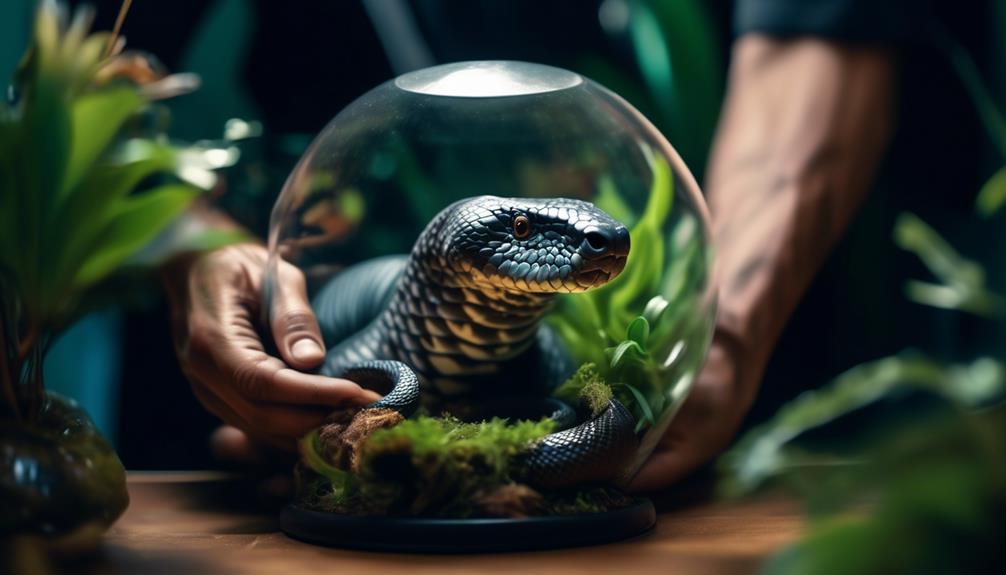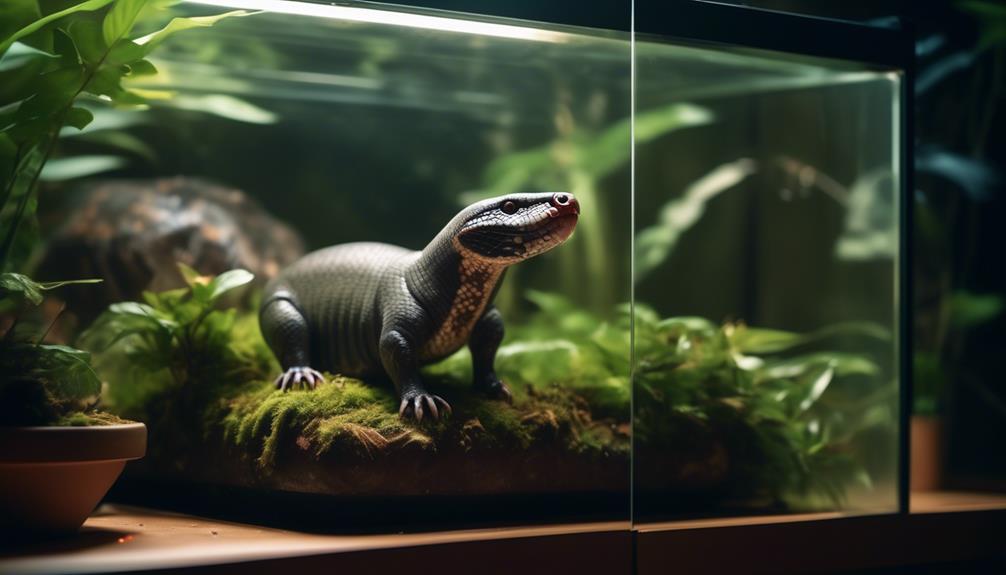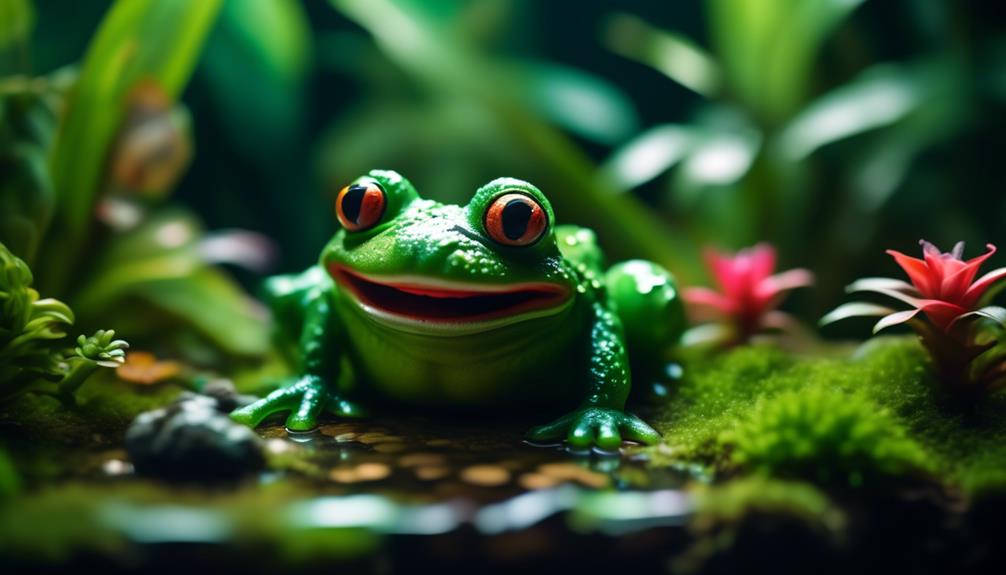Welcome to our comprehensive guide on the art of Rhino Rat Snake care. In this discussion, we will share essential information and guidelines to ensure the well-being and thriving existence of these intriguing reptiles.
From creating the ideal housing and environmental conditions to providing the necessary lighting and temperature requirements, we will explore all aspects of caring for these snakes.
But that's not all – we'll also uncover the secrets of feeding, handling, and general care to ensure a fulfilling and rewarding experience.
So, let's embark on this journey together and uncover the mastery of Rhino Rat Snake care.
Key Takeaways
- Rhino rat snakes require a spacious and secure enclosure with proper ventilation and escape-proof locks.
- Maintaining humidity levels between 50-100%, with an average of 75%, is important for the snake's well-being.
- UVB lighting is essential for the snake's health and activity levels, and a temperature gradient should be provided.
- The enclosure should be enriched with appropriate substrate, decorations, and hiding places to fulfill the snake's natural behaviors.
Housing and Environmental Requirements

When considering the housing and environmental requirements for Rhino Rat Snakes, it's essential to provide a secure and comfortable enclosure that meets their specific needs. The enclosure size should be a minimum of 5L x 2.5W x 2.5H, but larger dimensions are beneficial for the snake's overall well-being.
Cohabitation isn't recommended due to potential harassment and stress.
Maintaining proper humidity levels is crucial for these snakes. They prefer humidity levels between 50-100%, with an average humidity of around 75%. It's important for humidity levels to fluctuate naturally throughout the day and night.
To achieve this, mist the enclosure 1-2 times a day and use a reptile humidifier for nighttime fogging. Additionally, provide a water bowl for soaking and swimming, changing it daily and disinfecting it weekly.
Lighting and Temperature Requirements
To ensure the optimal health and well-being of Rhino Rat Snakes, it's crucial to provide proper lighting and temperature requirements in their enclosure.
Optimal lighting placement is essential for these snakes, as they're at least partially active during the day. UVB lighting is recommended to provide essential vitamin D and stimulate appetite and activity. It's best to use UVB bulbs such as Zoo Med Reptisun T5 HO 5.0 or Arcadia T5 HO Forest 6%. Proper placement and duration of UVB lighting is crucial for the snake's well-being.
Additionally, Rhino Rat Snakes are ectotherms and require a temperature gradient. Basking temperature should be around 90-95°F, while ambient temperature should be 75-80°F. Providing a temperature gradient allows the snake to regulate its body temperature effectively.
Substrate and Decorations

Now let's shift our focus to the important aspects of substrate and decorations for Rhino Rat Snake care.
Creating a naturalistic habitat for your snake is essential for its well-being. The substrate should resemble tropical soil and leaf litter, providing a thin layer for cushioning and aesthetics. Recommended substrates include Zoo Med Eco Earth, ReptiSoil, and Exo Terra Plantation Soil.
To enhance humidity and create a forest aesthetic, layer clean leaf litter on top of the substrate. Remember to replace the substrate every 3-4 months and promptly remove any soiled areas.
Enriching the enclosure with various decorations is also crucial. Provide at least two hiding places, a sturdy climbing branch, and foliage for your snake. Consider adding more branches, cork tubes, ledges, live or artificial plants, and leaf litter.
These enrichment activities will provide a stimulating and engaging environment for your snake's natural behaviors, promoting its overall well-being.
Feeding Requirements
Feeding requirements for Rhino Rat Snakes involve providing whole animal prey on a specific schedule to ensure their nutritional needs are met. Here are three important aspects to consider when it comes to feeding these snakes:
- Feeding Schedule: Rhino rat snakes have different feeding schedules based on their age. Hatchlings should be fed every 5-7 days, juveniles every 7-14 days, and adults every 14 days. Following these schedules will help maintain their health and growth.
- Prey Options: When it comes to prey, it's important to offer items that are equivalent to the snake's width or smaller if offering multiple feeders. While live prey can be used, frozen prey is generally safer and more humane. Always remember to thaw the prey in warm water before offering it to the snake.
- Nutritional Requirements: Rhino rat snakes are carnivores and require whole animal prey to meet their nutritional needs. Providing a varied diet with appropriate prey items will ensure they receive the necessary nutrients for their overall well-being.
Handling and General Care

When caring for Rhino Rat Snakes, it's important to handle them with care and provide general care that meets their specific needs. Snake behavior should be considered when handling these reptiles, as they aren't known to enjoy being held. Rhino rat snakes are better suited for display rather than regular handling.
It's recommended to let the snake come to you instead of grabbing it and to pick up the snake from below, supporting its body as much as possible. Additionally, it's crucial to provide regular health monitoring for the snake. Monitor the snake for signs of illness or injury, and seek veterinary care if any health issues arise.
Handling the snake with care and providing proper monitoring will help ensure its well-being.
Frequently Asked Questions
Can Rhino Rat Snakes Be Housed With Other Snake Species?
Socialization benefits can be outweighed by potential risks when housing rhino rat snakes with other snake species. It is not recommended due to potential harassment and stress. It is best to provide a secure and comfortable environment for the snake.
How Often Should the UVB Bulbs Be Replaced?
UVB bulbs for Rhino rat snakes should be replaced every 6-12 months to ensure optimal lighting. When it comes to the lighting needs of Rhino rat snakes, it is important to provide them with a UVB bulb that is appropriate for their enclosure.
Can Rhino Rat Snakes Be Kept in a Glass Enclosure?
Yes, rhino rat snakes can be kept in a glass enclosure. However, it's important to maintain the appropriate humidity levels. Ensure proper ventilation and use misting or a reptile humidifier to achieve the optimal humidity range of 50-100%.
What Should I Do if My Rhino Rat Snake Refuses to Eat?
If our rhino rat snake refuses to eat, we should first assess its behavior and body language. Understanding snake behavior and offering appropriate prey items can help resolve feeding issues. Seeking veterinary advice may be necessary.
Can Rhino Rat Snakes Be Kept in a Room With High Humidity Levels Already?
Yes, rhino rat snakes can be kept in a room with high humidity levels already. They thrive in humidity levels between 50-100%. However, it's important to monitor and maintain ideal room temperature for their well-being.
Conclusion
In conclusion, mastering the art of Rhino Rat Snake care requires dedication and attention to detail. By providing the right housing, environmental conditions, and proper handling, you can create a thriving and stimulating environment for these fascinating reptiles.
Remember, caring for a Rhino Rat Snake isn't just a hobby, it's an art form that allows you to connect with the wonders of nature. So embrace the challenge, become a snake whisperer, and unlock the secrets of these incredible creatures.
Happy snake keeping!



